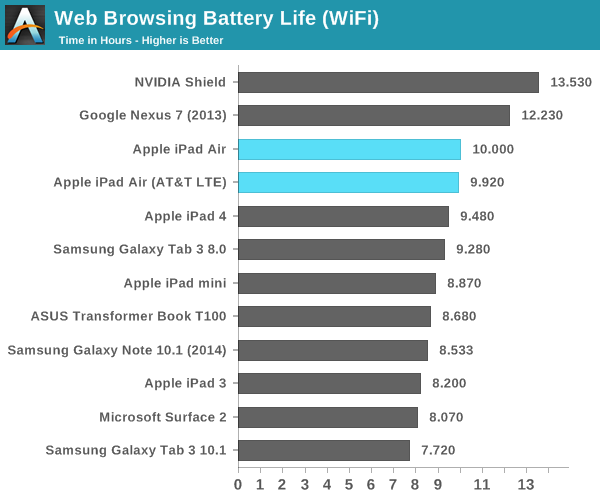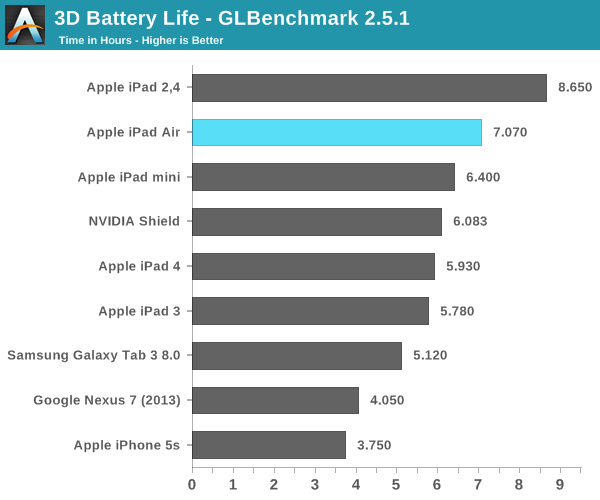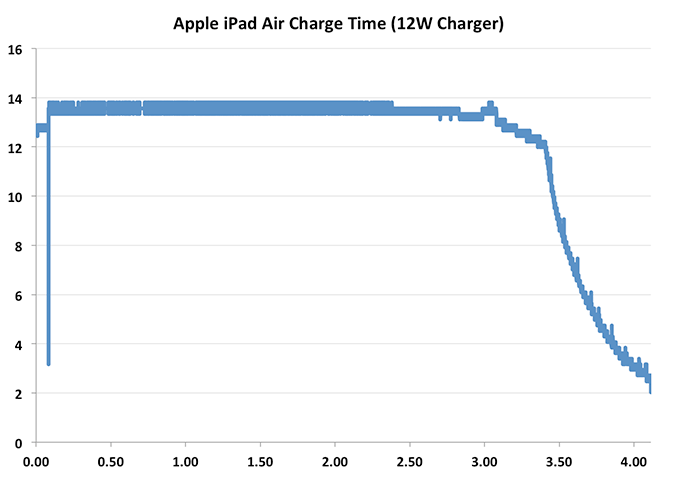The iPad Air Review
by Anand Lal Shimpi on October 29, 2013 9:00 PM ESTBattery Life
With the iPad Air Apple moved to a 32.4Wh battery, a significant decrease from the 42.5Wh unit in the 3rd and 4th generation iPads. The smaller battery doesn’t come with a change to Apple’s claim of 10 hours of battery life, which implies a reduction in overall platform power. I confirmed a substantial reduction in platform power in my crude measurements earlier in the article. Although it’s possible for the iPad Air to draw substantially more power than the iPad 4, our earlier power data seems to imply that it’s unlikely given the same exact workload. Our battery life tests agree.
We'll start with our 2013 smartphone/tablet web browsing battery life test. As always all displays are calibrated to 200 nits. The workload itself is hidden from OEMs to avoid any intentional gaming, but I've described it at a high level here.

Our web browsing workload came in at exactly 10 hours of continuous usage - an improvement compared to the iPad 4. Battery life on LTE was good as well, consistently delivering just under 10 hours of usage. The fact that both LTE and WiFi tests deliver similar results tells me that we may be bottlenecked by some other component in the system (perhaps display?).
I've been running the same video playback test for a while now, although we're quickly approaching a point where I'll need to move to a higher bitrate 1080p test. Here I'm playing a 4Mbps H.264 High Profile 720p rip I made of the Harry Potter 8 Blu-ray. The full movie plays through and is looped until the battery dies. Once again, the displays are calibrated to 200 nits:

Video playback battery life also improves slightly compared to the iPad 4. Apple’s battery life claims aren’t usually based around video playback, so exceeding their 10 hour suggestion here shouldn’t come as a shock. Apple’s video decode power has always been extremely low.
Our final cross-platform battery life test is based on Kishonti's Egypt HD test. Here we have a loop of the Egypt HD benchmark, capped to 30 fps, running on all of the devices with their screens calibrated to 200 nits.

Our 3D battery life rundown test shows a substantial improvement in battery life over the iPad 4. IMG’s PowerVR G6430, running a moderate workload, can do so more efficiently than any of the previous generation GPUs in Apple’s SoCs. Much like the A7’s CPU cores however, there’s a wider dynamic range of power consumption with the G6430. Running at max performance I would expect to see greater GPU power consumption. The question then becomes what’s more likely? Since the majority of iOS games don’t target the A7 (and instead shoot for lower end hardware), I would expect you to see better battery life even while gaming on the iPad Air vs the iPad 3/4.
Charge Time
The iPad Air comes with the same 12W USB charger and Lightning cable that we first saw with the iPad 4. Having to only charge a 32.5W battery means that charge times are lower compared to the iPad 3 and 4:

A full charge takes a little over 4 hours to complete. The adapter delivers as much as 12W to the iPad, drawing a maximum of 13.5W at the wall. I still think the sweet spot is somewhere closer to 2.5 hours but that’s another balancing game that must be played between charge time and maintaining battery health. It’s still so much better than the ~6 hours of charge time for the iPad 3 and 5.69 hours for the iPad 4.











444 Comments
View All Comments
Ryan Smith - Wednesday, October 30, 2013 - link
Which is the difference between having me do something, and having Anand do something. There is a very good reason he's The Boss, after all. He's a machine (figuratively speaking).;-)Krysto - Wednesday, October 30, 2013 - link
> A single CPU core can use up 8GB/s of bandwidth. I’m still vetting other SoCs, but so far I haven’t come across anyone in the ARM camp that can compete with what Apple has built here.Didn't Exynos 5250 have 17.5 GB/s bandwidth, according to Samsung's whitepaper? That would be more than 8GB/s per core.
raptorious - Wednesday, October 30, 2013 - link
Maybe if you're talking about L1 or L2 bandwidth, but not DRAM. The DRAM interface on that chip is 2x32 bit and it's clocked at DDR3-1600, which means it can reach a _peak theoretical max_ of 12.8 GB/s. Theoretical bandwidth is one thing, what the CPU can actually sustain to DRAM is a whole different story.AbbyYen - Wednesday, October 30, 2013 - link
the SHIELD is A BEAST!well done NVIDIA, now made it into tablet form with those battery. I don't care if it is a cylinder type, protrude the tablet if you have to so it won't lay flat on table and won't need no magic cover!
iPad for leisure only, play and usefulness is still Android!
darkcrayon - Wednesday, October 30, 2013 - link
Shield is much lower resolution, obviously. Remember also the iPad is (finally) getting official physical controller support, which makes it a potentially much more versatile device than the Shield. And clearly iOS is no slouch when it comes to developer support for games. About the only thing nvidia has here is the willingness to pay for more exclusives. How many people do you think would get a general purpose iPad and use it for awesome games vs buying a one-trick pony like the Shield?ddriver - Wednesday, October 30, 2013 - link
LOL, this is a new high (or low) in manipulative reviews, so now the A7 is faster than a Haswell? With all the money AT pockets in, one would thing they'd at least write a set of in-house REAL CPU benchmarks, especially after all the b1tching about manufacturers cheating in the 3rd party benchmarks that are widely available...Wilco1 - Wednesday, October 30, 2013 - link
It's not as unlikely as you think. An old Cortex-A9 gets half the performance of SB on SPECINT, and A15 is much closer still. Apple's A7 is even wider so should be able to beat a low clocked Haswell. That doesn't mean it can beat the 4GHz beasts - for that Apple would need to clock their A7 much higher and increase core counts, and that is unlikely for now.However I fully agree with you on Anand's state of benchmarks. That he still keeps using SunSpider (one of the most cheated on benchmarks) while at the same time talking about frequency changes as cheating is beyond me. And the claim of A7 being 6-wide is very dubious, it seems to me it's 4-way - it hasn't that much higher IPC than an A15.
thunng8 - Wednesday, October 30, 2013 - link
Not much lower IPC? You've got to be kidding right?A 1.9ghz A15 scores 920 in single core geekbench
A 1.3ghz Apple A7 scores 1400.
IPC looks to be about double on the Apple A7. In what world is double preset close.
Your assertion that deliberately changing frequency when detecting benchmark is not cheating is laughable.
Wilco1 - Wednesday, October 30, 2013 - link
Actually he 64-bit score includes hardware acceleration of crypto functions which artificially inflate the score. The 32-bit integer score is 1065 for 1.3GHz A7 vs 895 for 1.6GHz 5410. That's about 46% IPC gain, or just one generation. A57 will have almost the same IPC as A7, and is still 3-way OoO.Your idea that running a CPU at its designed maximum frequency is cheating is ridiculous. Ever done any benchmarking? I think not. The first thing you do when benchmarking is disable DVFS so you get meaningful and repeatable results at the maximum frequency.
errorr - Wednesday, October 30, 2013 - link
But how does that make benchmarks worthwhile if DVFS is disabled? I want to know if an aggressive throttle is applied in situations. If the DVFS table throttles in the middle of a benchmark the problem is the table.This just shows where ARM needs the most help compared to the other players. Intel and AMD are way ahead in power managment and the newer graphics even throttle much more intelligently, quicker, and with better granularity than any ARM chip. This is one of the last low hanging fruits in performance for such power limited chips. On die voltage regulation is a must for future generations.